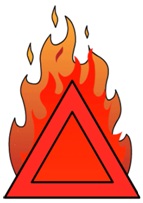|
This is the Fire Triangle. Actually it's a tetrahedron, because there are four elements that must be present for a fire to exist. There must be Oxygen to sustain combustion, Heat to raise the material to its ignition temperature, Fuel to support the combustion and a Chemical Reaction between the other three elements. The concept of Fire Prevention is based upon keeping these four elements separate. Click any of the 4 Elements to extinguish the fire. The Rules for Fighting Fires Just remember the three A's Activate the building alarm system or notify the fire department by calling 911. Or, have someone else do this for you. Assist any persons in immediate danger, or those incapable on there own, to exit the building, without risk to yourself. Only after these two are completed, should you Attempt to extinguish the fire.
Fire Extinguisher Use It is important to know the locations and the types of extinguishers in your workplace prior to actually using one. Fire Extinguishers can be heavy, so it's a good idea to practice picking up and holding an extinguisher to get an idea of the weight and feel. Take time to read the operating instructions and warnings found on the fire extinguisher label. Not all fire extinguishers look alike. Practice releasing the discharge hose or horn and aiming it at the base of an imagined fire. Do not pull the pin or squeeze the lever. This will break the extinguisher seal and cause it to lose pressure.
When it is time to use the extinguisher on a fire, Just remember to P.A.S.S.!
PullAimSqueezeSweep
Fire Extinguisher InspectionLike any mechanical device, fire extinguishers must be maintained on a regular basis to insure their proper operation. You, the owner or occupant of the property where fire extinguishers are located, are responsible for arranging your fire extinguishers' maintenance. Fire extinguishers must be inspected or given a "quick check" every 30 days. For most extinguishers, this is a job that you can easily do by locating the extinguishers in your workplace and answering the three questions to the right.
Fire Extinguisher MaintenanceIn addition, fire extinguishers must be maintained annually in accordance with local, state and national codes and regulations. This is a thorough examination of the fire extinguisher's mechanical parts; fire extinguishing agent and the expellant gas. Your fire equipment professional is the ideal person to perform the annual maintenance because they have the appropriate servicing manuals, tools, recharge materials, parts, lubricants, and the necessary training and experience.
|
Types of Fires Not all fires are the same. Different fuels create different fires and require different types of fire extinguisher agents. Click the links below for description
· Class A = Class A fires are fires in ordinary combustibles such as wood, paper, cloth, trash, and plastics.. · · · Class B = Class B fires are fires in flammable liquids such as gasoline, petroleum oil and paint. · · · Class C = Class C fires are fires involving energized electrical equipment such as motors, transformers, and appliances. Remove the power and the Class C fire becomes one of the other classes of fire. · · · Class D = Class D fires are fires in combustible metals such as potassium, sodium, aluminum and magnesium. · · · Class K = Class K fires are fires in cooking oils and greases such as animal fats and vegetable fats. · · Some type of fire extinguishing agents can be used on more than one class of fire. Others have warnings where it would be dangerous for the operator to use a particular fire extinguisher agent.
Types of Fire Extinguishers
Water and Foam = Water and Foam fire extinguishers extinguish the fire by taking away the heat element of the fire triangle. Foam agents also separate the oxygen element from the other elements.
Carbon Dioxide = Carbon dioxide fire extinguishers extinguish the fire by taking away the oxygen element of the fire triangle and also by removing the heat with a very cold discharge.
Dry Powder = Dry Powder extinguishers are similar to dry chemical except that they extinguish the fire by separating the fuel from the oxygen element or by removing the heat element of the fire triangle.
|









